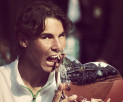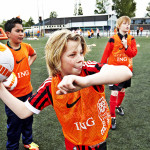How to create a Beyoncé or Nadal
‘You need some kind of predisposition or advantage to finally reach that level, but basically, you never know’, says Professor Nico van Yperen , one of the developers of the master. ‘You cannot prove that it’s constitution or learning experience. You only know what people did.’
In September 2015, a new research master – Talent Development & Creativity – will accept that challenge. The programme will be a part of the Faculty of Behavioural and Social Sciences. ‘Within psychology, we are interested in talent more broadly: in art and science, but also in sports’, Van Yperen says. ‘When you teach about what determines performance levels, you focus on the concept of talent.’
Looking backwards
Extreme talent is a high performing individual in any domain, such as a Nadal or a Federer, but also an Einstein or a Beyoncé. ‘There are all kinds of methodologies for how to map development by looking backwards at what makes them so successful.’
There are unique experiences in each person’s life that determine how far they end up going. For example, ‘if Nadal didn’t have such a devoted uncle, maybe he wouldn’t have become a top tennis player. So, maybe that is lucky’. But it’s never one single variable, and the master’s goal is to figure out what happened in the trajectory of a talented person that can be recognized, measured and developed.
Motivation, ability and opportunity
How? Recognition is done through assessment tests, such as selection criteria for university admissions to predict a student’s academic performance. For measurement, archival data, performance measures, and appraisals from coaches are used¬. Development involves the mental and social factors, such as being goal-committed and solution-focused, that influence how much a talented person achieves in his or her field.
‘What determines performance in any domain comes down to three factors: motivation, ability and opportunity’, Van Yperen explains. The programme will focus on the idea that talent is incremental rather than innate, even though disposition plays a clear role. ‘It’s discouraging for people to invest if they believe it’s primarily innate. If you are an incremental theorist, you believe that you can improve to a particular level.’
Magnum opus
But what role does creativity play in all of this? It’s creative talent in the traditional sense, as well as what the concept actually means: ‘How innovative or novel it is, and how feasible it is.’ That means that a visionary may come up with a seemingly brilliant idea, but if it can’t be made a reality, then it doesn’t count. ‘If it’s innovative but not feasible, then it’s not creative.’
In this regard, creativity is not literally an artist painting a masterpiece or a composer writing his magnum opus. ‘It depends on the domain. For scientists, that’s a new design or theory. In music, it can be a new perspective on work by Mozart, like how to play it and emphasize different things. Even in ice skating, the new klapschaats with a partly detached blade is innovative. It’s also about new ways of training.’





